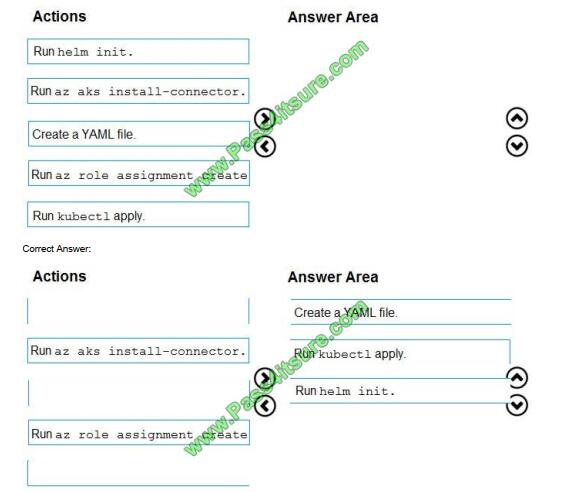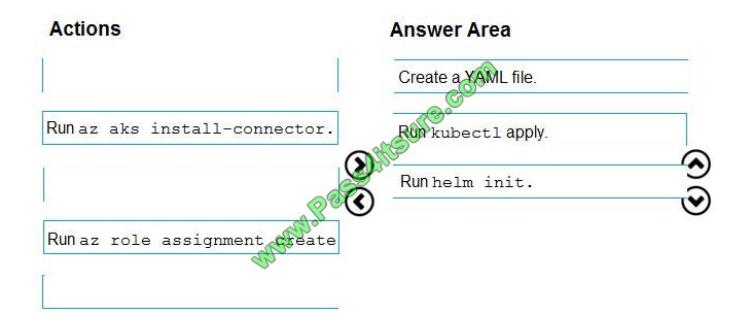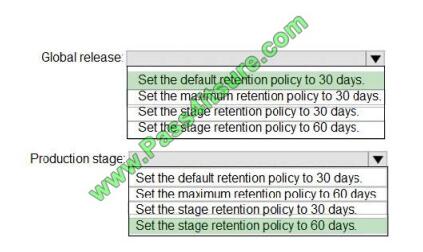This blog provides you with free online training and learning paths for Microsoft AZ-400. Not only provide AZ-400 dumps, But both VCE and PDF dumps contain the latest AZ-400 exam questions. Pass4itsure AZ-400 dumps are an important part of my AZ-400 exam study guide. Please get the latest Pass4itsure AZ-400 dumps here: https://www.pass4itsure.com/az-400.html (AZ-400 Q&As: 235).
- Microsoft Learn AZ-400 Exam Study Guide resources
- Microsoft Docs AZ-400 Study Guide Resources
- Microsoft AZ-400 PDF Dumps Free Download
- Microsoft AZ-400 Exam Video
- Latest Microsoft Azure AZ-400 Exam Questions Online
- Why choose Pass4itsure
- Pass4itsure Discount Code 2020
Microsoft Learn AZ-400 Exam Study Guide Resources
Microsoft Learn is an important part of my AZ-400 exam study guide.
- Develop an instrumentation strategy
- Develop a Site Reliability Engineering (SRE) strategy
- Develop a security and compliance plan
- Manage source control
- Facilitate communication and collaboration
- Define and implement continuous integration
- Define and implement a continuous delivery and release management strategy
Link: https://docs.microsoft.com/en-us/learn/certifications/devops-engineer
Microsoft Docs AZ-400 Study Guide Resources
One thing I always used to prepare for my Microsoft exams is Microsoft Docs. Here are the relevant Microsoft Docs which I used to prepare and study for the AZ-400 exam.
Microsoft AZ-400 PDF Dumps Free Download
| Free Download | Microsoft AZ-400 PDF Dumps |
| [drive] | https://drive.google.com/file/d/1BVx1Cj57Io-8FqWWnKhGDBUIFJcdThOd/view?usp=sharing |
Latest Microsoft Azure AZ-400 Exam Questions Online
QUESTION 1
Your company builds a multi-tier web application.
You use Azure DevOps and host the production application on Azure virtual machines.
Your team prepares an Azure Resource Manager template of the virtual machine that you will use to test new features.
You need to create a staging environment in Azure that meets the following requirements:
Minimizes the cost of Azure hosting
Provisions the virtual machines automatically Uses the custom Azure Resource Manager template to provision the
virtual machines What should you do?
A. In Azure Cloud Shell, run Azure CLI commands to create and delete the new virtual machines in a staging resource
group.
B. In Azure DevOps, configure new tasks in the release pipeline to deploy to Azure Cloud Services.
C. From Azure Cloud Shell, run Azure PowerShell commands to create and delete the new virtual machines in a staging
resource group.
D. In Azure DevOps, configure new tasks in the release pipeline to create and delete the virtual machines in Azure
DevTest Labs.
Correct Answer: D
You can use the Azure DevTest Labs Tasks extension that\\’s installed in Azure DevOps to easily integrate your CI/CD
build-and-release pipeline with Azure DevTest Labs. The extension installs three tasks: Create a VM Create a custom
image from a VM Delete a VM
The process makes it easy to, for example, quickly deploy a “golden image” for a specific test task and then delete it
when the test is finished.
References: https://docs.microsoft.com/en-us/azure/lab-services/devtest-lab-integrate-ci-cd-vsts
QUESTION 2
You plan to create an image that will contain a .NET Core application.
You have a Dockerfile file that contains the following code. (Line numbers are included for reference only.)

You need to ensure that the image is as small as possible when the image is built. Which line should you modify in the
file?
A. 1
B. 3
C. 4
D. 7
Correct Answer: A
Multi-stage builds (in Docker 17.05 or higher) allow you to drastically reduce the size of your final image, without
struggling to reduce the number of intermediate layers and files.
With multi-stage builds, you use multiple FROM statements in your Dockerfile. Each FROM instruction can use a
different base, and each of them begins a new stage of the build. You can selectively copy artifacts from one stage to
another,
leaving behind everything you don\\’t want in the final image.
References: https://docs.docker.com/develop/develop-images/multistage-build/#use-multi-stage-builds
QUESTION 3
You have a project in Azure DevOps. You have an Azure Resource Group deployment project in Microsoft Visual Studio
that is checked in to the Azure DevOps project.
You need to create a release pipeline that will deploy resources by using Azure Resource Manager templates. The
solution must minimize administrative effort.
Which task type should you include in the solution?
A. Azure Cloud Service Deployment
B. Azure RM Web App Deployment
C. Azure PowerShell
D. Azure App Service Manage
Correct Answer: C
There are two different ways to deploy templates to Azure DevOps Services. Both methods provide the same results, so
choose the one that best fits your workflow.
1.
Add a single step to your build pipeline that runs the PowerShell script that\\’s included in the Azure Resource Group
deployment project (Deploy-AzureResourceGroup.ps1). The script copies artifacts and then deploys the template.
2.
Add multiple Azure DevOps Services build steps, each one performing a stage task.
The first option has the advantage of using the same script used by developers in Visual Studio and providing
consistency throughout the lifecycle.
References:
https://docs.microsoft.com/en-us/azure/vs-azure-tools-resource-groups-ci-in-vsts
QUESTION 4
Your company has a project in Azure DevOps for a new web application.
The company identifies security as one of the highest priorities.
You need to recommend a solution to minimize the likelihood that infrastructure credentials will be leaked.
What should you recommend?
A. Add a Run Inline Azure PowerShell task to the pipeline.
B. Add a PowerShell task to the pipeline and run Set-AzureKeyVaultSecret.
C. Add a Azurre Key Vault task to the pipeline.
D. Add Azure Key Vault references to Azure Resource Manger templates.
Correct Answer: B
Azure Key Vault provides a way to securely store credentials and other keys and secrets.
The Set-AzureKeyVaultSecret cmdlet creates or updates a secret in a key vault in Azure Key Vault.
References: https://docs.microsoft.com/en-us/powershell/module/azurerm.keyvault/set-azurekeyvaultsecret
QUESTION 5
HOTSPOT
You are configuring a release pipeline in Azure DevOps as shown in the exhibit.

Use the drop-down menus to select the answer choice that answers each question based on the information presented
in the graphic.
NOTE: Each correct selection is worth one point.
Hot Area:

Correct Answer:

Box 1: 5 There are five stages: Development, QA, Pre-production, Load Test and Production. They all have triggers.
Box 2: The Internal Review stage References: https://docs.microsoft.com/en-us/azure/devops/pipelines/release/triggers
QUESTION 6
DRAG DROP
You are implementing a package management solution for a Node.js application by using Azure Artifacts.
You need to configure the development environment to connect to the package repository. The solution must minimize
the likelihood that credentials will be leaked.
Which file should you use to configure each connection? To answer, drag the appropriate files to the correct
connections. Each file may be used once, more than once, or not at all. You may need to drag the split bar between
panes or scroll
to view content
NOTE: Each correct selection is worth one point.
Select and Place:

Correct Answer:

QUESTION 7
HOTSPOT
Your company has an Azure subscription.
The company requires that all resource group in the subscription have a tag named organization set to a value of
Contoso.
You need to implement a policy to meet the tagging requirement.
How should you complete the policy? To answer, select the appropriate options in the answer area.
NOTE: Each correct selection is worth one point.
Hot Area:

Correct Answer:

Box 1: ” Microsoft.Resources/subscriptions/resourceGroups”
Box 2: “Deny”,
Sample – Enforce tag and its value on resource groups
}, “policyRule”: { “if”: { “allOf”: [
{
“field”: “type”, “equals”: “Microsoft.Resources/subscriptions/resourceGroups”
},
{
“not”: {
“field”: “[concat(\\’tags[\\’,parameters(\\’tagName\\’), \\’]\\’)]”,
“equals”: “[parameters(\\’tagValue\\’)]”
}
}
]
},
“then”: {
“effect”: “deny” } } } }
References: https://docs.microsoft.com/en-us/azure/governance/policy/samples/enforce-tag-on-resource-groups
QUESTION 8
DRAG DROP
You have an Azure Kubernetes Service (AKS) implementation that is RBAC-enabled.
You plan to use Azure Container Instances as a hosted development environment to run containers in the AKS
implementation.
You need to configure Azure Container Instances as a hosted environment for running the containers in AKS.
Which three actions should you perform in sequence? To answer, move the appropriate actions from the list of actions
to the answer area and arrange them in the correct order.
Select and Place

Correct Answer:

Step 1: Create a YAML file.
If your AKS cluster is RBAC-enabled, you must create a service account and role binding for use with Tiller. To create a
service account and role binding, create a file named rbac-virtual-kubelet.yaml
Step 2: Run kubectl apply.
Apply the service account and binding with kubectl apply and specify your rbac-virtual-kubelet.yaml file.
Step 3: Run helm init.
Configure Helm to use the tiller service account:
helm init –service-account tiller
You can now continue to installing the Virtual Kubelet into your AKS cluster. References: https://docs.microsoft.com/enus/azure/aks/virtual-kubelet
QUESTION 9
Note: This question is part of a series of questions that present the same scenario. Each question in the series contains
a unique solution that might meet the stated goals. Some question sets might have more than one correct solution,
while
others might not have a correct solution.
After you answer a question in this section, you will NOT be able to return to it. As a result, these questions will not
appear in the review screen.
You plan to create a release pipeline that will deploy Azure resources by using Azure Resource Manager templates.
The release pipeline will create the following resources:
Two resource groups
Four Azure virtual machines in one resource group
Two Azure SQL databases in other resource group
You need to recommend a solution to deploy the resources.
Solution: Create two standalone templates, each of which will deploy the resources in its respective group.
Does this meet the goal?
A. Yes
B. No
Correct Answer: B
Use a main template and two linked templates.
References: https://docs.microsoft.com/en-us/azure/azure-resource-manager/resource-group-linked-templates
QUESTION 10
You have a GitHub repository.
You create a new repository in Azure DevOps.
You need to recommend a procedure to clone the repository from GitHub to Azure DevOps.
What should you recommend?
A. Create a webhook.
B. Create a service connection for GitHub.
C. From Import a Git repository, click Import
D. Create a pull request.
E. Create a personal access token in Azure DevOps.
Correct Answer: C
QUESTION 11
HOTSPOT
How should you configure the release retention policy for the investment planning applications suite? To answer, select
the appropriate options in the answer area.
NOTE: Each correct selection is worth one point.
Hot Area:

Correct Answer:

Scenario: By default, all releases must remain available for 30 days, except for production releases, which must be kept
for 60 days.
Box 1: Set the default retention policy to 30 days
The Global default retention policy sets the default retention values for all the build pipelines. Authors of build pipelines
can override these values.
Box 2: Set the stage retention policy to 60 days
You may want to retain more releases that have been deployed to specific stages.
References: https://docs.microsoft.com/en-us/azure/devops/pipelines/policies/retention
QUESTION 12
DRAG DROP
You need to recommend a solution for deploying charts by using Helm and Tiller to Azure Kubernetes Service (AKS) in
an RBAC-enabled cluster.
Which three commands should you recommend be run in sequence? To answer, move the appropriate commands from
the list of commands to the answer area and arrange them in the correct order.
Select and Place:

Step 1: Kubectl create
You can add a service account to Tiller using the –service-account flag while you’re configuring Helm (step 2 below).
As a prerequisite, you’ll have to create a role binding which specifies a role and a service account name that have
been set up in advance.
Example: Service account with cluster-admin role
$ kubectl create -f rbac-config.yaml
serviceaccount “tiller” created
clusterrolebinding “tiller” created
$ helm init –service-account tiller
Step 2: helm init
To deploy a basic Tiller into an AKS cluster, use the helm init command.
Step 3: helm install
To install charts with Helm, use the helm install command and specify the name of the chart to install.
References:
https://docs.microsoft.com/en-us/azure/aks/kubernetes-helm
https://docs.helm.sh/using_helm/#tiller-namespaces-and-rbac
QUESTION 13
You have an Azure DevOps organization named Contoso and an Azure DevOps project named Project1.
You plan to use Microsoft-hosted agents to build container images that will host full Microsoft .NET Framework apps in a
YAML pipeline in Project1.
What are two possible virtual machine images that you can use for the Microsoft-hosted agent pool? Each correct
answer presents a complete solution.
NOTE: Each correct selection is worth one point.
A. vs2017-win2016
B. ubuntu-16.04
C. win1803
D. macOS-10.13
E. vs.2015-win2012r2
Correct Answer: BC
The Microsoft-hosted agent pool provides 7 virtual machine images to choose from:
Ubuntu 16.04 (ubuntu-16.04)
Windows Server 1803 (win1803) – for running Windows containers
Visual Studio 2019 Preview on Windows Server 2019 (windows-2019)
Visual Studio 2017 on Windows Server 2016 (vs2017-win2016)
Visual Studio 2015 on Windows Server 2012R2 (vs2015-win2012r2)
macOS X Mojave 10.14 (macOS-10.14)
macOS X High Sierra 10.13 (macOS-10.13)
References:
https://docs.microsoft.com/en-us/azure/devops/pipelines/agents/hosted?view=azure-devops
Why Choose Pass4itsure
High-quality test content is very important to us. Pass4itsure ensures that all objectives of the exam are covered so that you can prepare any questions in the exam.

Pass4itsure Discount Code 2020
Please read the picture carefully to get 12% off! Latest discount code “2020PASS” – Pass4itsure.

[Free] Microsoft AZ-400 PDF Dumps https://drive.google.com/file/d/1BVx1Cj57Io-8FqWWnKhGDBUIFJcdThOd/view?usp=sharing
P.S
If you are interested in taking the AZ-400 exam, you should know everything about the exam before you decide to start the exam. The latest free study guide is shared above, study hard! You can check the best study material for AZ-400 study guide from here : https://www.pass4itsure.com/az-400.html(AZ-400 dumps).
All the best !!